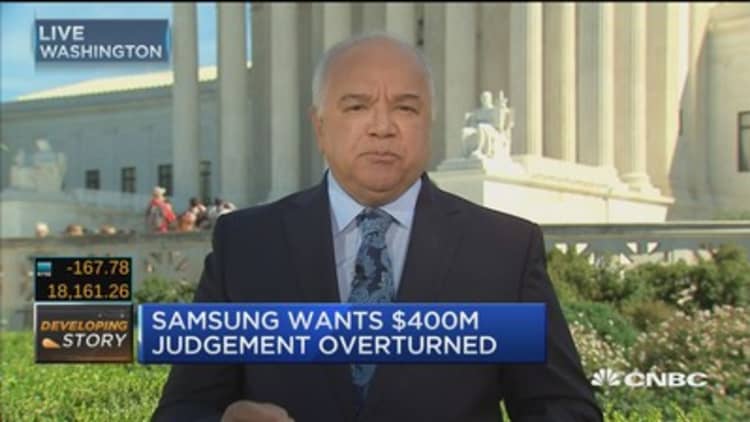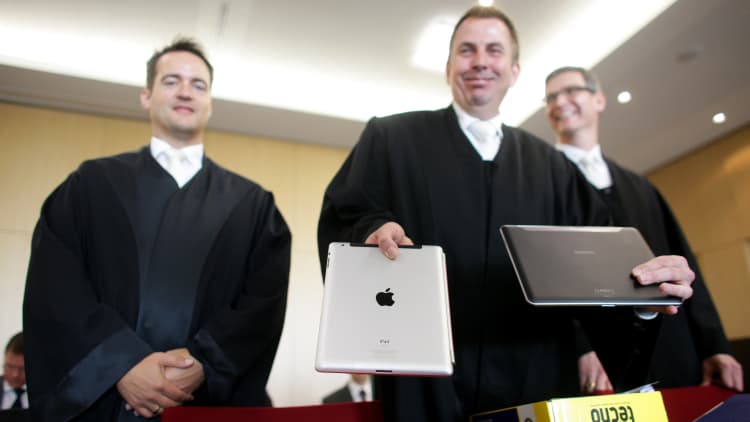
On Tuesday, a fight over patents between two smartphone giants came to the U.S. Supreme Court, with potentially wide-ranging implications for the technology industry.
A decision could take months. But the resulting opinion could set a precedent on whether the look and feel of a product — protected by design patents — entitles the designer to the entire profit, regardless of what's inside, legal experts said.
This case began in 2011, when Apple sued Samsung for copying design features of its devices, including, among other things, its colorful grid of app icons. Two lower courts ruled in Apple's favor on design-patent infringement.
At dispute is $400 million dollars, representing profits from Samsung smartphones, which Samsung was ordered to pay Apple.
That penalty is based on a federal law that says that a party copying and applying a patented design to "any article of manufacture" is liable "to the extent of his total profit."
"We firmly believe that strong design patent protection spurs creativity and innovation," said Noreen Krall, Apple's Chief Litigation Counsel, after the hearing this morning at the Supreme Court. "And that's why we've defended ourselves against those who steal our ideas."
Samsung counters that the $400 million penalty is disproportionate.
Specifically, the South Korean giant says Apple is not entitled to total profits from the entire phone, but only the profit from the components that infringe.
"When design patent law was created in the 17th century, products were much simpler," Samsung said in a statement. "It pertained to things like the handle of a spoon or a carpet pattern, which may have driven a purchase decision. By comparison, today, there are more than 200,000 patents in a single smartphone."
Beyond the $400 million, there is a broader principle at the center of this case that could ripple through the tech industry: What is the appropriate method to assess damages for design patent infringement?
Christopher Carani, a professor at Northwestern Pritzker School of Law, said that how the Supreme Court rules on that issue could have far-reaching implications.
"If we see a strong [decision] in favor of protecting these design rights, I think we're going to see more investment in design," Carani told CNBC. "People will have to push their designs further to make sure that they stay far away from other people's designs. But if we don't, then you might see more similar designs on the marketplace."

"The key here for the Supreme Court is to try and strike a balance that doesn't stifle competition but also spurs innovation," he said.
Silicon Valley is weighing in, but not all companies are on the same side.
Companies such as Facebook, eBay and Google have come to Samsung's defense. They argue that taking Samsung's total profits would lead to — in their words — "absurd results" and a devastating impact on companies that spend billions of dollars every year on research and development.
Modern technological products, so these companies say, "are not purchased primarily based on the design of one or more isolated components."
Apple CEO Tim Cook has plenty of powerful allies as well, both in and out of technology.
Fashion companies such as Tiffany, Adidas and Jenny Yoo have said the "total profits" rule "helps ensure that designers have the appropriate incentives and rewards to make investments in innovative designs," lamenting the rising costs of hunting down knock-offs and "design pirates."
Also, more than 100 well-known designers including Bentley's director of design, Microsoft's creative director and Calvin Klein signed a court brief supporting Apple in this battle.
Their argument: Apple is entitled to Samsung's entire profits because it's the design that motivates consumers to buy those products in the first place.
"History shows that a product's visual design drives sales and becomes the product itself in the minds of consumers," the designers argued.



